- Bernard Preston homepage
- Woodstove
- Firewood Processing Equipment
Firewood processing equipment
Firewood processing equipment must surely include a rack to hold the logs above the ground. This little gadget was very easy to cut and weld together. It has two main-functions.
- It saves you having to bend over whilst sawing.
- It keeps the teeth out of the earth; that is the chainsaw's public enemy, number-one.
It is sometimes called a saw horse and can be made of wood.
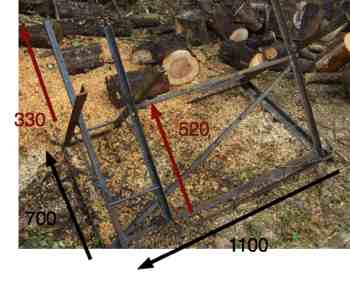
This page was last updated by Bernard Preston on 9th April, 2023.
If you own a chainsaw, then do yourself a favour and make this little horse; I used only steel off-cuts that I had lying around.
The first important requirement is that the base must be quite heavy; I used 40mm angle-iron, 5 millimetres thick. They are often made of timber.
Simply because of the lengths of the offcuts, I made it 1100mm long by 700 wide. That turned out to be just about perfect. They are measured in black.
Then I used six-pieces of 30mm angle iron, 4 millimetres thick for the uprights. With a bit of by guess, and by God, I cut them to 0.850m long. They crossed making the lower piece 520mm, and the upper 330; these measurements are marked in brown.
This worked out just right for logs up to about 400mm thick. For small-branches, say 50 millimetres, they tend to jump out. If you have a lot of that size, then I would angle the uprights more steeply. Having a second person holding them with a forked stick works well.
For logs larger than 400mm, I would make those uprights slightly longer and the angle rather less acute; but I haven't actually done that. For my needs 0.850m long was just about perfect.
Firewood processing equipment
The sawdust is perfect for the laying boxes of your chicken-tractor, should you have one. It's a portable cage for clearing your garden of cutworms and the remains of the last crop, whilst simultaneously the birds fertilise the ground.
You should just see the colour of the eggs; it's all about healthy living. No chemical additives to your chicken food is necessary to give bright yellow, almost orange yolks.
There is just one chicken tractor design at this page, though I have others. If you have a desire to go the next step it's not difficult if you have a welding-machine.

Firewood processing equipment like this horse are essential to protect your chainsaw-blade from dipping regularly into the earth.
Then you need to keep sharpening it, and that's a fag.
Then you need some struts to strengthen the whole structure. I used old square tubing, round and flat-bar, but anything would do.
You will have some quite heavy logs on here so it needs to be robustly made. I am no great-welder but this is pretty strong; it has stood up to plenty of hours of the chainsaw.
For long pieces, you can saw off the edge of the structure, but in the main you will be sawing between the two uprights that are about 200mm apart. Here obviously there must be no bridging-steel; marked in red.
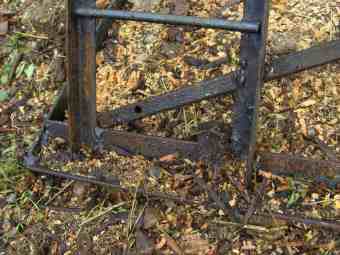
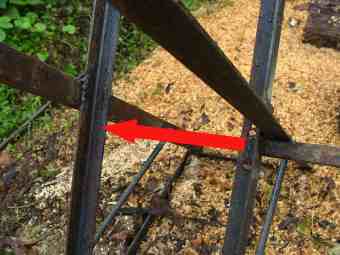
I shortened one of the uprights by about 50mm as it interfered with the chainsaw chassis.
A large pile of heavy-logs can be quite intimidating for the gardener who simply wants to be rid of some unwanted timber; turn them into firewood.
But you do need quite a powerful chainsaw for sawing large-logs; they are dangerous tools, and not for everyone.
I started with a small Husky that was marvelous for light-work around the garden, but proved completely inadequate for logs of more than 200mm.
I eventually took the plunge and bought a large powerful chainsaw; generally I avoid Chinese tools, but my forestry specialist recommended this Big Boy and I have to admit I'm very pleased with it. It starts easily; the only downside is the 60cc motor is a bit rough and ready, and needs double the amount of two-stroke oil.
Remember to disengage the chain before tugging on the cord. It needs two-pulls on full choke when starting it cold; at the first cough, reduce it to a half and off she goes.
She made short work of this pin-oak that came down in a heavy wind.
Cleaning the airfilter
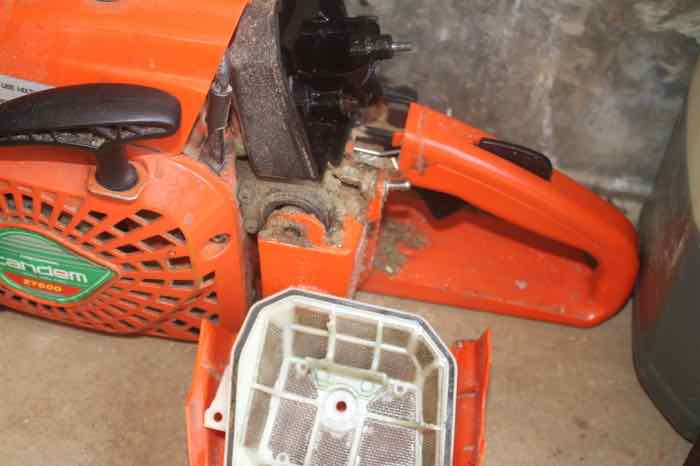
There are many types of air-filters for chainsaws. When clogged with dust the engine will no longer run properly, the fuel starved of oxygen.
Step one is simply to use an old toothbrush and some warm water. Give the filter a good scrub. Then take it to the local garage and blow air from inside to out. Bob's your uncle; you will notice an immediate difference in the power of the machine.
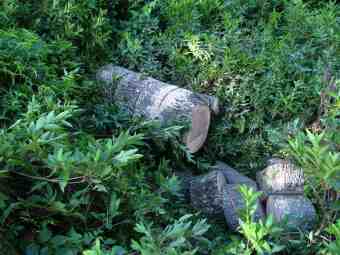
Actually, I was pleased it came down; it was shading the solar-panels in the early morning.
It's a lot of fun being a greenie, but it does mean spending hard-earned rands, or dollars, on equipment. The beauty of it is that you slowly get it back, but being in the red for a couple years is not to my liking.
Not having to buy firewood has made it all worthwhile; or calling in the tree-fellers every time an evergreen comes down in a heavy wind.
But a commercial firewood splitter is another story; that was quite pricey but just as essential for producing suitably-sized logs for our stove.
Massive fallen tree trunks
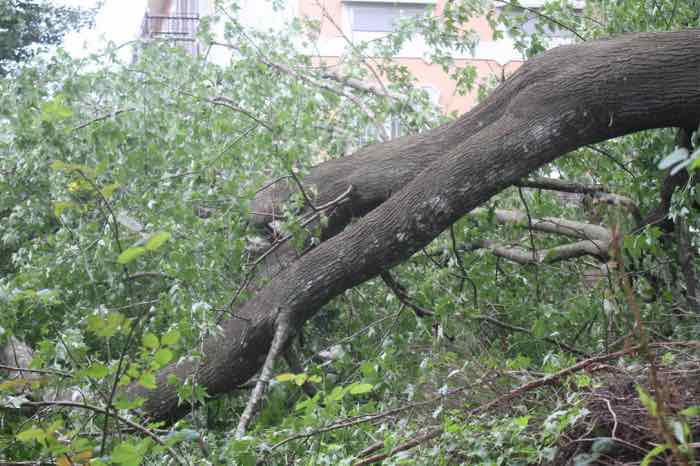
Have your own firewood processing equipment means that massive fallen trunks do not have to be a financial disaster. This is not a job to be tackled by those with no experience. The key is to start at the far end with the smallest branches, moving step by step towards the base of the tree.
Those with a love of carpentry and access to a planking machine can obviously make good use of the timber.
Finally the decision was made to pollard and save the tree; a Liquid Amber that is over a hundred years old. That obviously is a job for a professional. The backyard hacker should not leave the ground with his chainsaw.
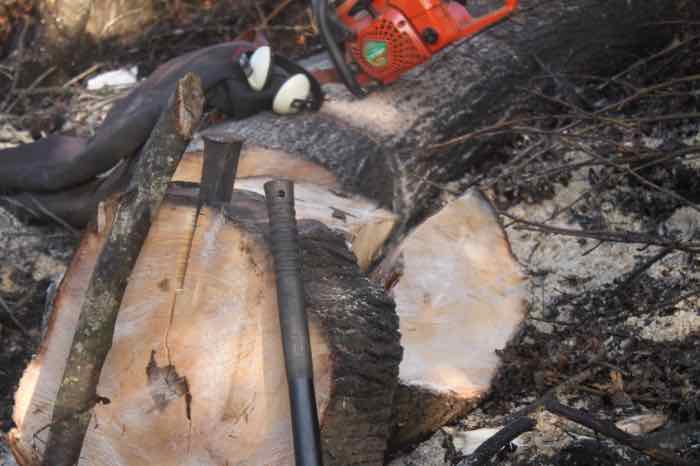 Sharpened wooden sticks make useful chisels.
Sharpened wooden sticks make useful chisels.Ear muffs and protective leggings are absolutely essential when using a chainsaw; never work without them.
Then a heavy chisel with a slight twist, and a 14-pound hammer make splitting easier. Large logs like this are too heavy to move.
A sharpened stick like that shown above is very useful for driving into the crack when the chisel will go no further.
Never put fingers into that crack.
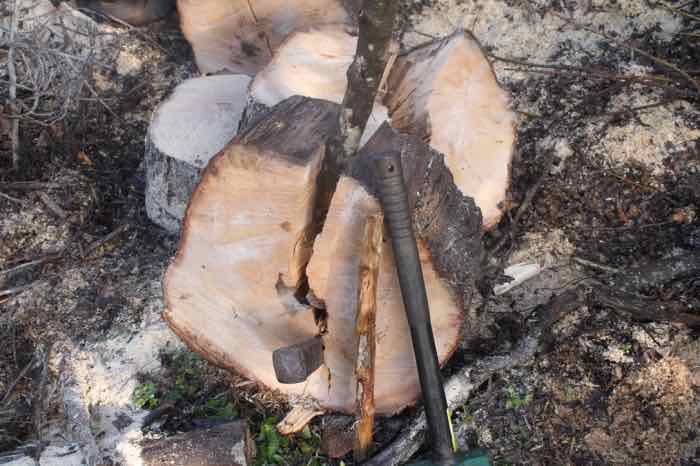
A number of sharpened sticks about 40cm long and from 15 to 30 millimetres in diameter are extremely useful when the steel chisel will go no further. Hit them with the hammer. They don't last too long; just make another.
Now you have a manageable log to move to the commercial splitter.
This is not a job for the faint-hearted; nor for those who love to spend hours watching ballgames. But if you enjoy working out of doors and want to save a mint instead of purchasing firewood then perhaps it's for you.
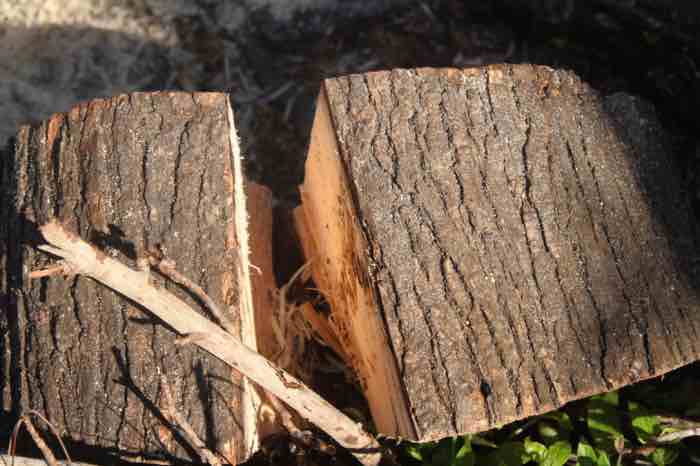
Woodstove heating system
This woodstove heating system means instant-heat in Bernard Preston's home; it is astonishing just how quickly the chimney starts radiating warmth into the room. Literally within minutes one can feel the difference, and after a short period the flue has to be closed down, or you will cook.
Your firewood processing equipment makes your stove a lot more friendly somehow; you aren't constantly having to buy timber in the winter.
A regular supply of hot-water is just one other benefit of woodstoves.
Woodstove heating system compares very favourably with an old-fashioned fireplace; no dangerous sparks onto the carpet and a fraction of the ash.
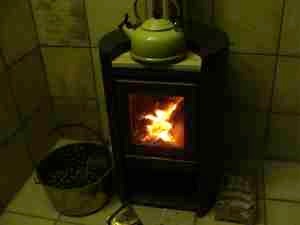
Make sure the woodstove you purchase has a little area for heating water and preparing food. It makes for the perfect slow-cooker.
Bernard Preston
Bernard Preston is a self-confessed greenie; becoming resilient in the face of all the challenges associated with climate change initially takes quite a lot of hard work and expense. But now we have harvested rainwater, electricity and warmth from the logs our garden supplies; and enough fresh produce, free from pesticides to feed an army.
The firewood processing equipment came in so useful this winter; unexpected heavy snow on the Drakensberg, and rain in our village meant not only a full-reservoir but also plenty of work sawing and splitting timber.
It took about three-years to put all these systems in place; now it's payback time for all the hard work.
Now we are into worm-farms and chicken tractors and other interesting things. It's a rich life and a lot more fun than watching others having pleasure on television.
Firewood processing equipment links
When browsing use right click and "Open Link in New Tab" or you may get a bad gateway signal.
Newsletter
Our newsletter is entitled "create a cyan zone" at your home, preserving both yourself and Mother Earth for future generations; and the family too, of course. We promise not to spam you with daily emails promoting various products. You may get an occasional nudge to buy one of my books.
Here are the back issues.
- Lifestyle and ideal body weight
- What are ultra-processed foods?
- Investing in long-term health
- Diseases from plastic exposure
- Intensive lifestyle management for obesity has limited value
- A world largely devoid of Parkinson's Disease
- The impact of friendly bacteria in the tum on the prevention of cancer
- There's a hole in the bucket
- Everyone is talking about weight loss drugs
- Pull the sweet tooth
- If you suffer from heartburn plant a susu
- Refined maize meal and stunting
- Should agriculture and industry get priority for water and electricity?
- Nature is calling
- Mill your own flour
- Bake your own sourdough bread
- Microplastics from our water
- Alternative types of water storage
- Wear your clothes out
- Comfort foods
- Create a bee-friendly environment
- Go to bed slightly hungry
- Keep bees
- Blue zone folk are religious
- Reduce plastic waste
- Family is important
- What can go in compost?
- Grow broad beans for longevity
- Harvest and store sunshine
- Blue zone exercise
- Harvest and store your rainwater
- Create a cyan zone at your home
Did you find this page interesting? How about forwarding it to a friendly book or food junkie? Better still, a social media tick would help.
- Bernard Preston homepage
- Woodstove
- Firewood Processing Equipment
Address:
56 Groenekloof Rd,
Hilton, KZN
South Africa
Website:
https://www.bernard-preston.com